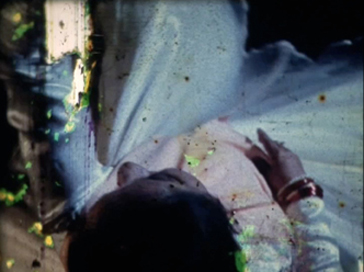
Born in 1964 in Swansea (UK).Lives and works in New York (US)

2008 - 2011
Film 16 mm
Durée : 12'58''
Year of Purchase: 2010
“Reality is cinema in nature.” 0
“The term origin is not intended to describe the process by which the existent came into being, but rather to describe that which emerges from the process of becoming and disappearance. Origin is an eddy in the stream of becoming, and in its current it swallows the material involved in the process of genesis. That which is original is never revealed in the naked and manifest existence of the factual; its rhythm is apparent only to a dual insight. On the one hand, it needs to be recognized as a process of restoration and re-establishment, but, on the other hand, and precisely because of this, as something imperfect and incomplete”01
Priya is the first name of Priya Pawar, a traditional Indian dancer practicing the Kathak style—from the Sanskrit “katthaka,” meaning “one who tells a story.” The present work is an encounter between two artists, two storytellers.
Alia Syed is an artist of the British cinema avant-garde, of Muslim Indian origin, exiled in her youth in Pakistan, and now residing in London. Her work explores the questions of identity and representation, reflecting a way of life where, thanks to cultural multiplicity, one embodies several places in a single moment. Open and polysemic, Syed’s work draws inspiration from the aesthetic of avant-garde cinema: its formal freedom, social critique and political responsibility, its allegoric poetry, and technical and economic emancipation. A film of Syed’s is an “in-between,” a place of exchange between rhythmic and cyclical elements, characters, places, texts, images, and sounds, in a deconstruction of narration.
Priya is an experimental 16mm film shot using high-angle view, showing Priya Pawar dancing the steps of a Kathak against a dark background, attired in traditional dress and jewelry. In its modern representation, Kathak is absorbed into the Indian cinematographic tradition as “mujra,” a courtesan dance which the artist both cultivates and ruins. Sound is abolished in a haptic silence. The film is above all a cinematographic experience both sensory and spectatorial.
The synopsis is a two-fold dance: Priya spins around counterclockwise, then makes two, three mad turns in the other direction. Her white dress reignites again and again its ghostly, hypnotic twirl.
The film transports us into the dynamic of movement; then the image becomes gradually corrupted by a “hand made” effect—spreading the contamination of Pictorialist representation, which brings to mind experimental films of the 1960s.1 The image is disfigured until it’s reduced to that “beyond the image” made of earth-stained luminosity. At times, the dancer emerges from her endless merry-go-round, a visual echo of an ecstasy into which the viewer finds himself projected—he can see nothing. In the last part, a confrontation of the dance and of expressionist-abstract “disruption” is balanced in a dual vision: movement-image/paradoxical image, plastic image/plasmic image. And the film runs in a loop.
The artist buried the film Priya for a year and a half in her garden, mixed like composted matter with paper, vegetable debris, and organic refuse. The term “underground” in avant-garde cinema is here taken literally. Nature and time are put to work. Humidity attacks the layer of emulsion producing unexpected and indescribable results. The process of degradation is a plastic, poetic, and symbolic operation, and the work of the soil plays here the role of the final process of development. It becomes a story of balancing creation and destruction, echoing the ecstasy of the dance. Destruction as an element of natural history is a subversive gesture—burying a film in a garden as if it were a dead dog—yet which finds an element of romanticism in this domestic production dear to the avant-garde: making films like one tends to one’s garden. The formless is thought of as the origin of a form always hidden within it, its state of gestation, its becoming. Vanitas is fed with a form of melancholy of the alteration of things and beings by time—an “aesthetic of immanence.” 2
Priya presents itself a sort of “true travel,” a unique experience characterized by “the magical accidents, the discoveries, the inexplicable wonders and the wasted time, regained at the end of the film.” 3
Luc Jeand’heur
0 Pier Paolo Pasolini, “The Written Language of Reality” (1966), in: Heretical Empiricism, ed. L. K. Barnett (Indiana University Press, 1988), p. 197.
01 Walter Benjamin, The Origin of German Tragic Baroque Drama, trans. John Osborne (Verso, 1998; orig. 1963, written 1928), p. 48.
1 The experimental cinema of the 1960s, one of the artist’s inspirations.
2 Georges Didi-Huberman.
3 Raoul Ruiz, Poetics of Cinema I: Miscellanies, trans. Brian Holmes (Éditions des Voirs, 1995), p. 78.